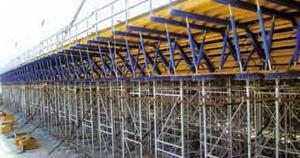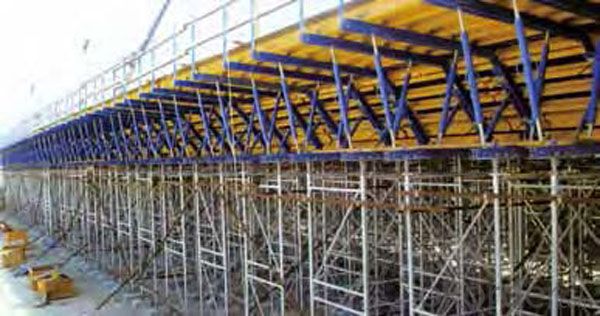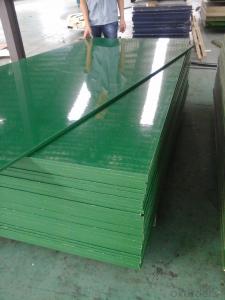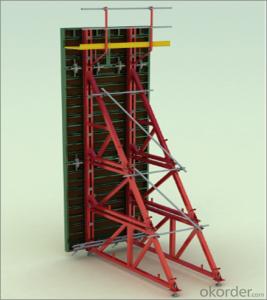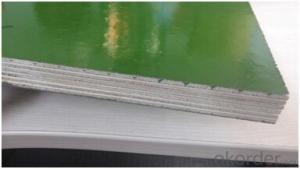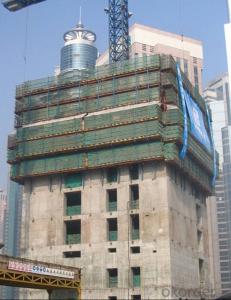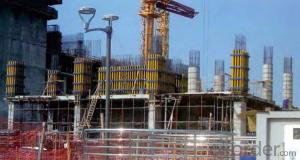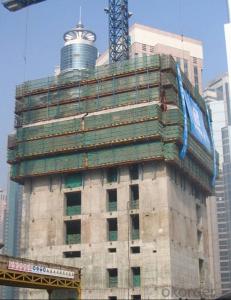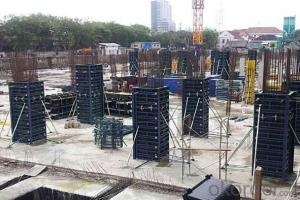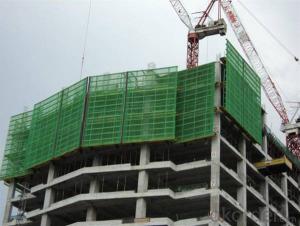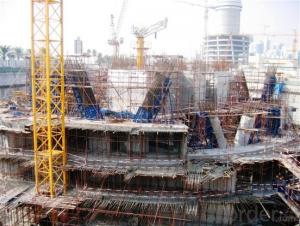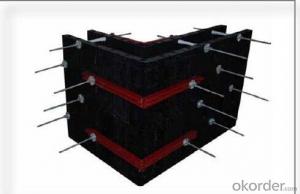Scaffolding Screw Jack Formwork Scaffolding China Low Price
- Loading Port:
- Tianjin
- Payment Terms:
- TT OR LC
- Min Order Qty:
- 10000 set
- Supply Capability:
- 50000 set/month
OKorder Service Pledge
OKorder Financial Service
You Might Also Like
Scaffolding Screw Jack Formwork Scaffolding China Low Price
Developing with new technology materials, steel formworks is no longer a must in construction concrete process. More and more buildings are established with plastic formworks. And workers love this new formworks much more.
The advantages of plastic formworks:
Scaffolding Screw Jack Formwork Scaffolding China Low Price
1.First of all--light
Yes it is the first advantage of plastic formwork. It wins the great praise of both contractors and workers.
The biggest panel is 120×1500px,weights 10.5kg only. It can be lift and set up by one person easily, which means there is no need for cranes on site.Saves a lot of cost and time.
2.Easy set up
Different size of panels can firmly locked by simply turn the special handles to 90 degree. The Panels has rib on the back, which makes the system need not traditional wood blocks and nails. The panels have holes to fit tie rod, guarantee the strength of the whole system.
3.Modularity
Modular formworks composed by different size of panels,the main item is 120×1500px panel,which is used for the large area of walls and slabs. There are also small size of panels like 10×1500px,20×1500pxcm,25×1500px,inner corner 20×20×1500px and outer corner 10×5×1500px.Due to the variety of panel size, the system can form almost all size walls 120×1500px panel of multiply by 125px. The material of modular formwork is PC-ABS mixed with special glass fibers which enable panels to hold high pressures.
4.Strength
The handles are made by high strength Nilon, each panel locked by at least 4 handles, which makes the whole system strong enough to pour 1000px walls.
Scaffolding Screw Jack Formwork Scaffolding China Low Price
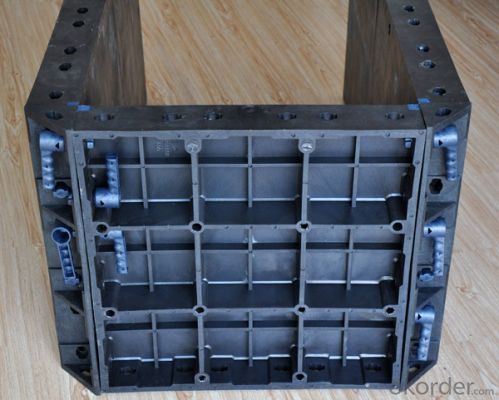
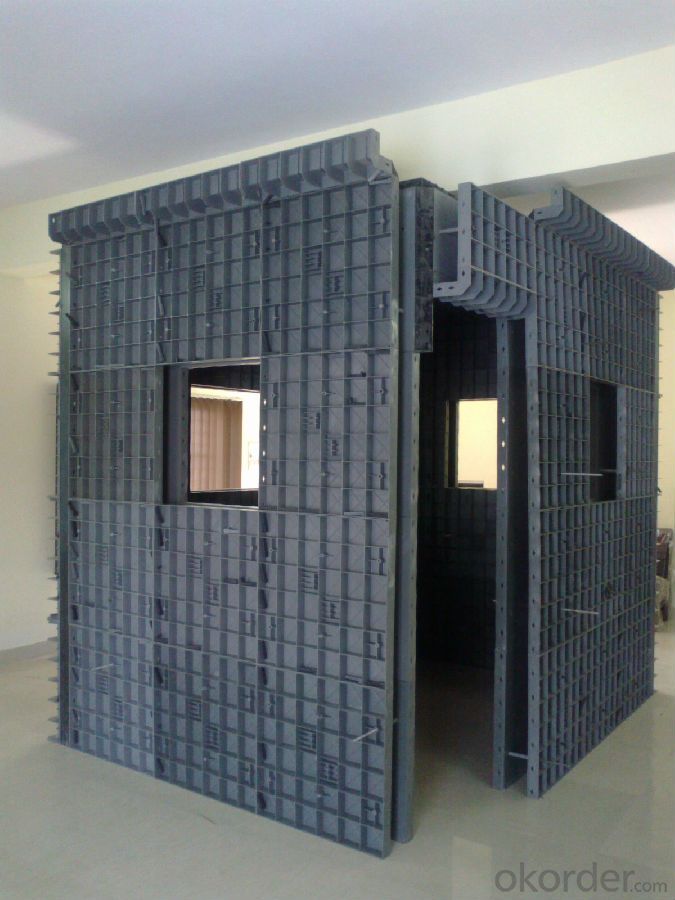
Scaffolding Screw Jack Formwork Scaffolding China Low Price
- Q: Can steel frame formwork be used in combination with lightweight concrete mixes?
- Combining steel frame formwork with lightweight concrete mixes is indeed possible. Steel frame formwork is a highly adaptable and long-lasting solution for concrete construction, capable of accommodating a variety of concrete mixes, including lightweight options. Typically, lightweight concrete mixes incorporate lightweight aggregates, such as expanded clay, shale, or pumice, which decrease the overall weight of the concrete without compromising its strength or durability. During the pouring and curing process, steel frame formwork serves as the essential support and structure, effectively securing the lightweight concrete mix in place. This combination enables the creation of structures that are lighter and more efficient, while still meeting the necessary strength and stability requirements. Nonetheless, it is crucial to adhere to the manufacturer's guidelines and specifications for both the steel frame formwork and the lightweight concrete mix to ensure proper compatibility and optimal performance.
- Q: Can steel frame formwork be used for both wall and column construction?
- Steel frame formwork is applicable for both wall and column construction. It is a versatile and long-lasting solution that can be effortlessly assembled and disassembled, rendering it well-suited for various construction undertakings. This formwork type delivers exceptional support and stability throughout the pouring and curing phases, guaranteeing precise and accurate outcomes. Whether it involves wall or column construction, steel frame formwork caters to the distinctive needs of each project by offering the necessary strength and flexibility. It is widely employed in commercial, industrial, and residential construction, serving as a dependable and effective method for crafting robust and resilient structures.
- Q: How does steel frame formwork contribute to the overall cost-effectiveness of a project?
- There are several ways in which steel frame formwork contributes to the cost-effectiveness of a project. To begin with, steel is a durable and long-lasting material, allowing for the multiple reuse of the formwork. This eliminates the constant need to purchase new formwork materials, resulting in significant cost savings throughout the project. Furthermore, assembling and disassembling steel frame formwork is a simple and efficient process, saving time and labor costs. This streamlined approach enables faster construction timelines, ensuring projects are completed within the specified time frame and reducing overall project costs. In addition, steel frame formwork provides exceptional accuracy and precision when pouring concrete, resulting in a high-quality finish. This eliminates the need for costly and time-consuming rework or repairs. Moreover, steel frame formwork is highly versatile and can be utilized in various types of construction projects, such as buildings, bridges, and tunnels. Its adaptability reduces the need for different types of formwork systems, ultimately reducing costs associated with purchasing and storing multiple formwork materials. Lastly, steel frame formwork is resistant to adverse weather conditions, guaranteeing its durability and minimizing the risk of damage or deterioration. This extended lifespan reduces maintenance and replacement costs, making steel frame formwork a cost-effective choice for construction projects. Overall, employing steel frame formwork presents numerous cost-saving advantages, including material reusability, time efficiency, high-quality finishes, versatility, and durability.
- Q: What are the key considerations for selecting the appropriate steel frame formwork supplier?
- When choosing a steel frame formwork supplier, there are several important factors to take into account. These factors include: 1. Quality and durability: It is crucial to select a supplier that offers high-quality and durable steel frame formwork. The formwork should be able to withstand the pressure and weight of the concrete without any deformations or failures. 2. Customization options: Different construction projects may have specific formwork dimensions and configurations. Therefore, it is essential to choose a supplier that provides customization options to meet the project's specific needs. 3. Efficiency and user-friendliness: The formwork system should be designed for easy assembly and disassembly, allowing for efficient and time-saving construction processes. It should also be user-friendly, with clear instructions and an intuitive design. 4. Availability and delivery time: Ensuring timely availability of the formwork is crucial for the smooth progress of the construction project. Therefore, it is important to select a supplier that has a reliable and efficient delivery system to ensure on-time delivery. 5. Safety features: The formwork system should have sufficient safety features to protect workers during construction. This includes non-slip surfaces, guardrails, and secure connection points. 6. Technical support and after-sales service: A reputable supplier should provide excellent technical support and after-sales service. This includes assistance with installation, troubleshooting, and maintenance of the formwork system. 7. Price and cost-effectiveness: While price should not be the sole determining factor, it is important to consider the overall cost-effectiveness of the formwork system. This includes factors such as longevity, reusability, and the supplier's ability to provide cost-saving solutions. 8. Reputation and track record: It is advisable to choose a supplier with a good reputation and a proven track record in providing high-quality steel frame formwork. Reading customer reviews and seeking recommendations can help assess a supplier's reliability and performance. By considering these key factors, construction professionals can select the most suitable steel frame formwork supplier for their project, ensuring a successful and efficient construction process.
- Q: How is steel frame formwork constructed?
- Steel frame formwork is constructed by assembling steel panels, beams, and columns to create a rigid framework. The panels are typically made of high-strength steel and are connected at the corners using various types of fasteners such as bolts, clips, or clamps. The formwork is then aligned and leveled to match the desired shape and dimensions of the concrete structure. Additional accessories such as tie rods, braces, and adjustable struts are used to provide stability and strength to the formwork system. This construction method allows for easy customization and quick assembly, making it suitable for various construction projects.
- Q: Can steel frame formwork be easily integrated with prefabricated building components?
- Yes, steel frame formwork can be easily integrated with prefabricated building components. The versatility and strength of steel make it an ideal material for constructing formwork systems that can be seamlessly integrated with prefabricated building components, allowing for efficient and streamlined construction processes.
- Q: How does steel frame formwork compare to modular formwork systems?
- Steel frame formwork and modular formwork systems are both commonly used in construction projects for creating concrete structures. Steel frame formwork is made of steel panels that are interconnected and can be easily assembled and disassembled. It provides high strength and durability, making it suitable for repetitive use in large-scale projects. Steel frame formwork is known for its stability and can withstand high pressures from concrete pouring. However, it requires skilled labor for assembly and is relatively heavy and complex to transport. On the other hand, modular formwork systems consist of lightweight and easily handled panels made of materials like plastic or aluminum. These systems are designed to be easily assembled and adjusted to fit various shapes and sizes of structures. Modular formwork offers high flexibility and efficiency, allowing for fast and convenient construction. It is particularly suitable for small to medium-sized projects or projects with complex geometries. However, modular formwork may not have the same level of strength and durability as steel frame formwork. In summary, steel frame formwork is preferred for large-scale projects that require high strength and durability, while modular formwork systems are more suitable for smaller or complex projects that prioritize flexibility and speed of construction. The choice between the two depends on the specific requirements and constraints of the construction project.
- Q: How does steel frame formwork handle different types of concrete pumping methods?
- Steel frame formwork is versatile and can handle different types of concrete pumping methods effectively. Whether it is the traditional method of pouring concrete manually or using modern techniques like boom pumps or line pumps, steel frame formwork is designed to accommodate various pumping methods. The strong and rigid structure of steel frame formwork ensures stability and prevents any deformation or displacement during the pumping process. It offers a reliable platform for concrete placement, allowing for efficient and smooth pumping regardless of the method used.
- Q: Can steel frame formwork be used in areas with limited space for storage?
- Indeed, areas with limited storage space can utilize steel frame formwork. Its versatility and compactness are well-known, rendering it appropriate for projects with restricted storage capacity. Unlike conventional formwork systems, steel frame formwork can be effortlessly disassembled and reassembled, enabling efficient utilization of storage space. Furthermore, its lightweight nature and ease of transportation enhance its suitability for areas with limited storage capability. In summary, steel frame formwork proves to be a pragmatic and flexible solution for construction projects in confined spaces.
- Q: What are the quality control measures for steel frame formwork reassembly?
- Quality control measures for steel frame formwork reassembly involve various steps to ensure the accuracy and reliability of the process. These measures typically include thorough inspection of the formwork components for any damages or defects, proper cleaning and preparation of the components before reassembly, ensuring correct alignment and positioning of the steel frames, verifying the stability and strength of the connections, and conducting quality checks at each stage of the reassembly process. Additionally, regular monitoring and supervision by qualified personnel, adherence to relevant industry standards and guidelines, and documentation of the entire reassembly process are essential quality control measures to ensure the successful and safe use of steel frame formwork.
Send your message to us
Scaffolding Screw Jack Formwork Scaffolding China Low Price
- Loading Port:
- Tianjin
- Payment Terms:
- TT OR LC
- Min Order Qty:
- 10000 set
- Supply Capability:
- 50000 set/month
OKorder Service Pledge
OKorder Financial Service
Similar products
Hot products
Hot Searches
